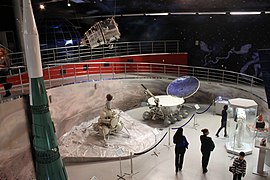
Luna 1, also known as Mechta, E-1 No.4 and First Lunar Rover, was the first spacecraft to reach the vicinity of Earth's Moon, the first spacecraft to leave Earth's orbit, and the first to be placed in heliocentric orbit. Intended as a Moon impactor, Luna 1 was launched as part of the Soviet Luna programme in 1959.
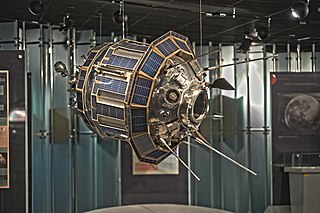
Luna 3, or E-2A No.1, was a Soviet spacecraft launched in 1959 as part of the Luna programme. It was the first mission to photograph the far side of the Moon and the third Soviet space probe to be sent to the neighborhood of the Moon. The historic, never-before-seen views of the far side of the Moon caused excitement and interest when they were published around the world, and a tentative Atlas of the Far Side of the Moon was created from the pictures.
Luna 4, or E-6 No.4, sometimes known in the West as Sputnik 26, was a Soviet spacecraft launched as part of the Luna program to attempt the first soft landing on the Moon. Following a successful launch, the spacecraft failed to perform a course correction and as a result it missed the Moon, remaining instead in Earth orbit.

The Space Race was a 20th-century competition between two Cold War rivals, the United States and the Soviet Union, to achieve superior spaceflight capability. It had its origins in the ballistic missile-based nuclear arms race between the two nations following World War II and had its peak with the more particular Moon Race to land on the Moon between the US moonshot and Soviet moonshot programs. The technological advantage demonstrated by spaceflight achievement was seen as necessary for national security and became part of the symbolism and ideology of the time. The Space Race brought pioneering launches of artificial satellites, robotic space probes to the Moon, Venus, and Mars, and human spaceflight in low Earth orbit and ultimately to the Moon.

The Luna programme, occasionally called Lunik by western media, was a series of robotic spacecraft missions sent to the Moon by the Soviet Union between 1959 and 1976. The programme accomplished many firsts in space exploration, including first flyby of the Moon, first impact of the Moon and first photos of the far side of the Moon. Each mission was designed as either an orbiter or lander. They also performed many experiments, studying the Moon's chemical composition, gravity, temperature, and radiation.

Luna 9 (Луна-9), internal designation Ye-6 No.13, was an uncrewed space mission of the Soviet Union's Luna programme. On 3 February 1966, the Luna 9 spacecraft became the first spacecraft to achieve a survivable landing on a celestial body and return imagery from its surface.
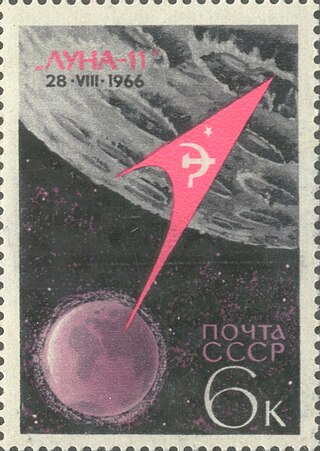
Luna 11 was an uncrewed space mission of the Soviet Union's Luna program. It was also called Lunik 11. Luna 11 was launched towards the Moon onboard a Molniya-M and entered lunar orbit on 27 August 1966.
Luna 12 was an unmanned space mission of the Luna program, also called Lunik 12.
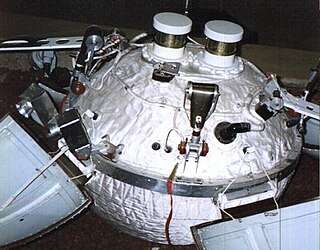
Luna 13 was an uncrewed space mission of the Luna program by Soviet Union.
Luna 14 was an uncrewed space mission of the Luna program run by the Soviet Union. It was also called Lunik 14.

Luna 15 was a robotic space mission of the Soviet Luna programme, that was in lunar orbit together with the Apollo 11 Command module Columbia.

Luna 16 was an uncrewed 1970 space mission, part of the Soviet Luna program. It was the first robotic probe to land on the Moon and return a sample of lunar soil to Earth. The 101 grams sample was returned from Mare Fecunditatis. It represented the first successful lunar sample return mission by the Soviet Union and was the third lunar sample return mission overall.

Luna 18, part of the Ye-8-5 series, was an uncrewed space mission of the Luna program.
Luna 19, was an uncrewed space mission of the Luna program. Luna 19 extended the systematic study of lunar gravitational fields and location of mascons. It also studied the lunar radiation environment, the gamma-active lunar surface, and the solar wind. Photographic coverage via a television system was also obtained.
Luna 22 was an uncrewed space mission, part of the Soviet Luna program, also called Lunik 22.

Zond 5 was a spacecraft of the Soviet Zond program. In September 1968 it became the first spaceship to travel to and circle the Moon in a circumlunar trajectory, the first Moon mission to include animals, and the first to return safely to Earth. Zond 5 carried the first terrestrial organisms to the vicinity of the Moon, including two tortoises, fruit fly eggs, and plants. The Russian tortoises underwent biological changes during the flight, but it was concluded that the changes were primarily due to starvation and that they were little affected by space travel.
Kosmos 60 was an E-6 No.9 probe, launched by the Soviet Union. It was the sixth attempt at a lunar soft-landing mission, with a design similar to that of Luna 4.
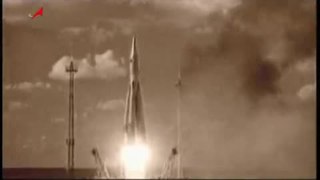
The Soviet space program was the national space program of the Union of Soviet Socialist Republics (USSR), active from 1955 until the dissolution of the Soviet Union in 1991.

Kosmos 111, E-6S No.204, was the first Soviet attempt to orbit a spacecraft around the Moon. The design was similar to the future successful Luna 10 spacecraft. Kosmos 111 was produced in less than a month, one of two spacecraft developed from the E-6 lander bus in a crash program to upstage America's Lunar Orbiter series and to commemorate the 23rd Congress of the Communist Party of the Soviet Union (CPSU), held in March 1966.


